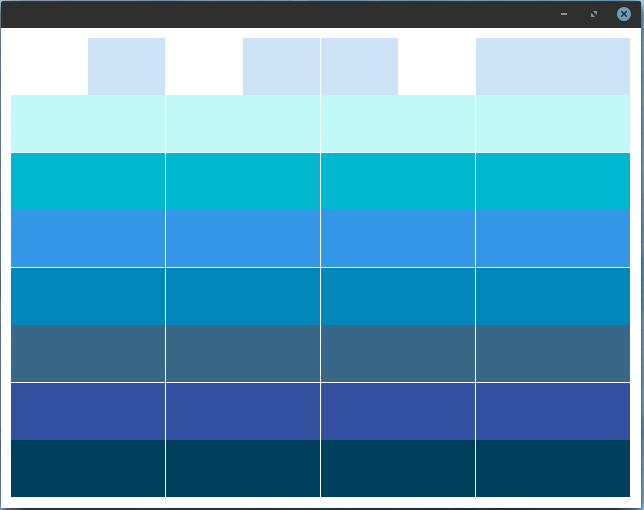I haven't written much for a while on these issues about python and PyQt5.
Today I will show a complex example of
QtMultimedia and how to create a spectrum equalizer.
First, the PyQt5 bindings come with this python module named
QtMultimedia.
The main reason was the lack of time and focus of my effort on more stringent elements of my life.
Let's start with the few lines of source code that show us how can use this python module.
[mythcat@desk ~]$ python3
Python 3.7.6 (default, Jan 30 2020, 09:44:41)
[GCC 9.2.1 20190827 (Red Hat 9.2.1-1)] on linux
Type "help", "copyright", "credits" or "license" for more information.
>>> import PyQt5
>>> from PyQt5.QtMultimedia import *
>>> dir(PyQt5.QtMultimedia)
['QAbstractVideoBuffer', 'QAbstractVideoFilter', 'QAbstractVideoSurface', 'QAudio', 'QAudioBuffer',
'QAudioDecoder', 'QAudioDeviceInfo', 'QAudioEncoderSettings', 'QAudioFormat', 'QAudioInput', 'QAudioOutput',
'QAudioProbe', 'QAudioRecorder', 'QCamera', 'QCameraExposure', 'QCameraFocus', 'QCameraFocusZone',
'QCameraImageCapture', 'QCameraImageProcessing', 'QCameraInfo', 'QCameraViewfinderSettings',
'QImageEncoderSettings','QMediaBindableInterface', 'QMediaContent', 'QMediaControl', 'QMediaMetaData',
'QMediaObject', 'QMediaPlayer', 'QMediaPlaylist', 'QMediaRecorder', 'QMediaResource', 'QMediaService',
'QMediaTimeInterval', 'QMediaTimeRange', 'QMultimedia', 'QRadioData', 'QRadioTuner', 'QSound', 'QSoundEffect',
'QVideoEncoderSettings', 'QVideoFilterRunnable', 'QVideoFrame', 'QVideoProbe', 'QVideoSurfaceFormat',
'__doc__', '__file__', '__loader__', '__name__', '__package__', '__spec__']
The next issue is creating a random equalizer effect with bars.

This source doesn't use the QtMultimedia but can be implemented in the random area of equalizer set by
update_values function:
import random
import sys
from PyQt5 import QtCore, QtGui, QtWidgets
from PyQt5.QtCore import Qt
from PyQt5.QtCore import pyqtSignal as Signal
print("load all modules!")
class Equalizer_Bars(QtWidgets.QWidget):
def __init__(self, bars, steps, *args, **kwargs):
super().__init__(*args, **kwargs)
# this fit the size to equalizer bars area
self.setSizePolicy(
QtWidgets.QSizePolicy.MinimumExpanding,
QtWidgets.QSizePolicy.MinimumExpanding
)
# set the size of the window
self.setMinimumHeight(480)
self.setMinimumWidth(640)
if isinstance(steps, list):
# list of colours.
self.n_steps = len(steps)
self.steps = steps
elif isinstance(steps, int):
# int number of bars, defaults to blue.
self.n_steps = steps
self.steps = ['blue'] * steps
else:
raise TypeError('steps variable set wrong, try with a list or int')
# create bars
self.set_bars = bars
# define settings of bars
self.set_space_between_bars = 1
self.set_height_of_bars = 1
# set color of background
self.set_background_color = QtGui.QColor('white')
# set padding by pixel .
self.set_padding = 10
# create timer
self.set_timer = None
# set decay for move bars
self.set_decay_frequency_ms(76)
self.set_decay_value= 10
# set values for minim and maxim
self.set_min_value = 0
self.set_max_value = 100
# store all current values in a list.
self.set_all_values= [0.0] * bars
def paintEvent(self, e):
# create a painter
painter = QtGui.QPainter(self)
# create a brush for drawing
brush = QtGui.QBrush()
brush.setColor(self.set_background_color)
brush.setStyle(Qt.SolidPattern)
rect = QtCore.QRect(0, 0, painter.device().width(), painter.device().height())
painter.fillRect(rect, brush)
# set the canvas.
d_height = painter.device().height() - (self.set_padding * 2)
d_width = painter.device().width() - (self.set_padding * 2)
# set the bars.
step_y = d_height / self.n_steps
bar_height = step_y * self.set_height_of_bars
bar_height_space = step_y * (1 - self.set_space_between_bars) / 2
step_x = d_width / self.set_bars
bar_width = step_x * self.set_space_between_bars
bar_width_space = step_x * (1 - self.set_height_of_bars) / 2
for i in range(self.set_bars):
# calculating the y position for this bar for stop, from the value in range.
c = (self.set_all_values[i] - self.set_min_value) / (self.set_max_value - self.set_min_value)
n_steps_to_draw = int(c * self.n_steps)
for n in range(n_steps_to_draw):
brush.setColor(QtGui.QColor(self.steps[n]))
rect = QtCore.QRect(
self.set_padding + (step_x * i) + bar_width_space,
self.set_padding + d_height - ((1 + n) * step_y) + bar_height_space,
bar_width,
bar_height
)
painter.fillRect(rect, brush)
painter.end()
def _trigger_refresh(self):
self.update()
def set_decay_trick(self, f):
self.set_decay_value= float(f)
def set_decay_frequency_ms(self, ms):
if self.set_timer:
self.set_timer.stop()
if ms:
self.set_timer = QtCore.QTimer()
self.set_timer.setInterval(ms)
self.set_timer.timeout.connect(self.set_decay_beat)
self.set_timer.start()
def set_decay_beat(self):
self.set_all_values= [
max(0, v - self.set_decay_value)
for v in self.set_all_values
]
self.update() # Redraw new position.
def size_values(self, v):
self.set_all_values= v
self.update()
def values(self):
return self.set_all_values
def set_range(self, vmin, vmax):
assert float(vmin) < float(vmax)
self.set_min_value, self.set_max_value = float(vmin), float(vmax)
# will be used with QBrush
def setColor(self, color):
self.steps = [color] * self._bar.n_steps
self.update()
def set_color_bars(self, colors):
self.n_steps = len(colors)
self.steps = colors
self.update()
def set_bar_padding(self, i):
self.set_padding = int(i)
self.update()
def set_bar_solid_percent(self, f):
self._bar_solid_percent = float(f)
self.update()
def set_background_color(self, color):
self.set_background_color = QtGui.QColor(color)
self.update()
class Window(QtWidgets.QMainWindow):
def __init__(self):
super().__init__()
self.equalizer = Equalizer_Bars(8, \
['#00405e', '#3350a1', '#386787','#0088ba','#3396e6', '#00b9d0','#c1f9f9', '#cce2f7'])
self.setCentralWidget(self.equalizer)
self.set_timer = QtCore.QTimer()
self.set_timer.setInterval(100)
self.set_timer.timeout.connect(self.update_values)
self.set_timer.start()
def update_values(self):
self.equalizer.size_values([
min(100, i+random.randint(0, 500) if random.randint(0, 10) > 2 else i)
for i in self.equalizer.values()
])
# start the program
app = QtWidgets.QApplication([])
w = Window()
w.show()
app.exec_()

